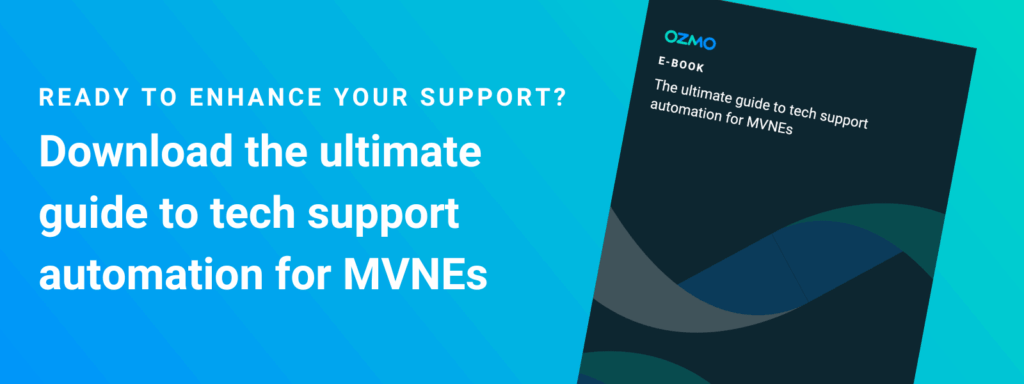MVNEs are the unsung heroes of the telecom sector. Without them, MVNOs would likely struggle to survive. But what is an MVNE vs an MVNO?
MVNEs, or mobile virtual network enablers, work behind the scenes to support MVNOs (mobile virtual network operators). MVNEs provide the technology and infrastructure, allowing MVNOs to focus on customer acquisition.
Even though they’re behind the scenes, good tech support is still vital to MVNE success. However, MVNEs face a number of customer service challenges that can impact the relationship with their MVNO partners. If left unaddressed, these issues can hurt key business metrics such as customer retention rate.
Below, we go over the most common MVNE customer service challenges and steps you can take to fix them.
Customer service: A critical component of MVNE success
MVNEs provide the technology, services and tools MVNOs rely on. For example, an MVNE is often responsible for eSIM activation and network access. MVNOs have no shortage of options when it comes to choosing an MVNE. MVNE leaders looking to differentiate their brand should harness the power of customer service to gain a competitive advantage.
No longer just a contact center hub, customer service is now a revenue driver for MVNEs. The quality of your customer service shapes your company’s reputation in the telecom industry. Research shows that improving the customer experience decreases churn by 15%.
The importance of customer service can’t be overstated. 54% of B2B customers say they’re willing to switch service providers if they have a poor service experience. Most MVNEs don’t want to risk losing over half of their customer base, especially when you consider it can cost up to seven times more to acquire new customers than to retain current ones. That’s why it’s important to address common MVNE customer service challenges before issues arise.
So, what are the most pressing MVNE customer service challenges in today’s market? We dive into a few examples below, along with tips on how to overcome them and differentiate your brand.
MVNE customer service challenge one: Siloed support
There is no such thing as a customer who uses a single channel to interact with your business. Yet, the myth of the one-channel customer persists, so companies use multichannel support, leading to siloed, inconsistent experiences.
B2B buyers usually use multiple channels during the customer journey, so it’s essential to create a unified, cohesive experience for MVNO customers. In a survey by McKinsey, over half of B2B respondents said they would switch service providers if they experienced inconsistent support across channels.
How to solve it: Leverage omnichannel customer service
So, what’s an MVNE company to do to reduce customer churn? When it comes to B2B buyers such as MVNOs, omnichannel customer service is the gold standard. Unlike multichannel support, which provides access to information across multiple channels, omnichannel customer support ensures access to information across channels using a single, unified approach.
With multichannel tech support, the quality of customer service varies depending on whether a customer calls in to a contact center, sends an email, or uses a chatbot. Omnichannel customer service ensures customers have access to the same quality tech support and information, regardless of how they choose to get in touch with your business.
This is because your team has a single platform of truth to work from, creating a better, streamlined service experience. For MVNEs looking to attract and retain MVNO clients, prioritizing omnichannel customer service is critical to success.
Challenge two: Lack of scalable tech support options
MVNEs support multiple MVNOs, each with its own unique needs, systems and customer bases. MVNOs can be incredibly niche. For example, some MVNOs exclusively cater to seniors, digital nomads or immigrant communities.
The needs of an MVNO that supports seniors will look different from one that focuses on affordable international calls for immigrants to contact family abroad. Yet, to stay competitive, MVNEs still need to serve these very diverse MVNO businesses effectively.
An increase in customers often results in a corresponding rise in tech support requests. This can create a strain on your resources, creating longer wait times for ticket resolution and making it difficult to scale your tech support and your business.
As a result, customer rage and dissatisfaction can increase, raising the risk of higher churn rates. These poor customer service experiences can lead to decreased MVNO satisfaction, hurting your brand’s reputation.
How to solve it: Prioritize scalable tech support
MVNOs want to know they can count on an MVNE to address their tech issues fast. MVNE tech support solutions are critical for driving revenue and helping multiple MVNO partners scale business operations quickly.
Help your customers help their clients by providing scalable tech support as a value-added service. This prevents your customers from losing out on valuable opportunities by streamlining the onboarding process for their own customers. Also, it can provide potential cost savings since they don’t have to build and maintain their own tech support architectures. Instead, they can focus on acquiring new customers for their business.
So, how can you help customers scale their tech support (while ensuring your own can meet increased demand)? One way to do it is by leveraging automated support. These days, self-service technology is essential for telecom customer support. Tools such as interactive tutorials can help streamline customer onboarding and device troubleshooting.
Additionally, tools like chatbots can deliver quality customer service. Chatbots are no longer relegated to handling simple FAQs. They now leverage large language models (LLMs) to better understand the nuances of customers’ requests and can handle increasingly complex troubleshooting. Plus, chatbots are available 24/7, so your customers (and their customers) can access the tech support they need at any time of day or night.
Challenge three: MVNEs offer resolutions too late
Most of the time, service providers are chasing down customers after something has happened, in the hopes that they’ll give the company a second chance. However, addressing issues after the fact often means you’re trying to get them to win them over after they’ve changed their mind.
As mentioned earlier, over half of B2B customers will leave after a bad service experience. These are customers who have already made up their mind and are unlikely to change it, with one foot already out the door.
Poor tech support can have a devastating impact on customer retention and your company’s bottom line. It’s estimated that globally, bad customer service costs businesses up to $3.7 trillion each year. So, what can your company do to avoid becoming another statistic?
How to solve it: Harness the power of proactive support
Most companies send a survey after a service interaction to ask customers for feedback. This is called reactive support, and as mentioned earlier, it’s often too late in the customer journey.
Instead, MVNEs should leverage proactive support to stay competitive. Proactive customer service means anticipating issues before they happen. So what does this look like in action?
Proactive customer service is about reaching customers earlier in their journey with your brand. It starts during the customer onboarding process when a company educates them on all the features and functions of their devices or services.
Proactive support also means diagnosing and providing tools to resolve issues before something happens, or teaching customers about finding and using self-service tools.
Automated support tools are critical to proactive customer support. Self-service can shine during network disruptions, which inevitably happen to even the best MVNEs. For example, if an outage takes voice services down, customers are unable to call in to your contact center for help.
However, if self-service options are available, customers can use those to access the instant, reliable support they need, even during network disruptions. By leveraging proactive customer support, you can help your company differentiate itself from the competition.
Overcome common MVNE customer service challenges with confidence
Customer service is no longer a nice-to-have, but a must-have for MVNEs looking to attract and retain more MVNO customers. Companies that prioritize tech support will drive long-term success both for themselves and their MVNO partners.
By assessing your current strategy against these common customer service challenges and taking steps outlined here to overcome them, you can help your brand stand out in an increasingly crowded telecom market.
Are you looking for more information on how to streamline tech support and deliver better outcomes for your MVNO partners? Our free e-book explores how MVNEs can leverage tech support automation as a competitive advantage, empowering MVNOs to achieve success. Download your copy today!




